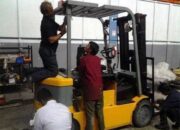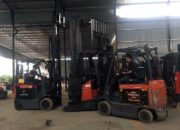Safe operation and maintenance of electric forklifts
Related systems and responsibility for maintaining safe operating rules for electric forklifts. Rules and procedures for safe operation.
Safe forklift operation procedures
Electric forklifts and internal combustion forklifts are nearly identical in shape and construction, respectively. But there is a difference in the exact operation method: Since the drive speed and direction of motion of the electric forklift is achieved by changing the current and changing the direction of rotation of the motor, so:
It has no mechanical clutch device and is controlled directly by the accelerator (electrical accelerator). Direction switches are used to change the steering direction (forward or reverse) of the forklift. The drive motor has no idle speed and the forklift starts up as soon as the electric motor operates. Its speed is controlled by the synchronizer. The working equipment (fork and tilt) of an electric forklift is the same as that of an internal combustion forklift.
The operation method of electric forklift trucks is basically the same. However, due to the difference in design and construction, they also have their own characteristics. During operation, it must be operated according to the specifications and operating sequence, otherwise the control system will protect itself and cannot work properly. The number of operations and the weight of each mechanism must be passed several times to achieve proficiency, accuracy and safety.
Safety steps when operating an electric forklift
Before working, drivers should wear protective clothing according to regulations.
Shoes for the following technical test and operation for electric forklifts:
Check the electrolyte level and specific gravity of the battery. The liquid level of the electrolyte in the battery shall not be lower than the separator. The specific gravity of the electrolyte must meet the requirements. The voltage of the battery shall not be less than the specified voltage and the specific gravity of the electrolyte shall not be less than the specified specific gravity. The electric forklift control system has the function of protecting the life of the battery: When the electricity on the meter shows overvoltage protection, it is necessary to charge it in time, clean and tighten the electrode joints.
Check the power line. All wiring connections should be tight and in good contact, fuses and fuses should be in good condition, and each switch and handle should be in the stopped position.
Close the emergency stop switch, open the ignition and check that appliances, lights, speakers, etc. Is it working normally?
Check the steering mechanism, it should be flexible and light.
Check the brake device, it should be flexible and reliable.
Check that the bearings and related running parts are well lubricated and flexible.
Check the forklift’s travel and hydraulic system for normal operation, especially the pipelines, couplings, oil cylinders, distribution valves, etc. Is there an oil leak in the hydraulic components?
Check to ensure that the shock absorber, presser mechanism, horizontal mechanism, lifting chain, truss, etc. are in good working order and reliable in use.
Find bugs, remove them promptly and never drive out with bugs.
Notes on starting and driving an electric forklift
Before driving, the driver should first check and clean the site and aisle to be suitable for forklift operation.
Correct sequence of operations when starting: sit in the driver’s seat with the correct posture → close the emergency stop switch → the diverter switch and the accelerator pedal are in a relaxed state → unlock the electric lock → release the handbrake → correct the position of the vehicle. change direction → tap the accelerator step by step → honk the horn → start slowly and accelerate gradually. It is strictly forbidden to step on the accelerator more than 20% without turning on the ignition, otherwise the control system will appear “high pedal” protection. The forklift fails to start when “operation sequence” and “high pedal” “Protection fault occurs, turn off the ignition switch, re-implement the above operating sequence correctly, the fault will automatically be eliminated.
When driving, you should accelerate gradually, and do not leave the vehicle at low speeds for long periods of time.
It is strictly forbidden to move the navigation switch while driving, only after the vehicle has come to a complete stop. Flip the direction switch to change direction so try to avoid. Do not apply emergency braking. In an emergency, the emergency stop switch must be quickly turned off and the electric lock must be turned off.
Horn when starting or turning when turning, going downhill, uneven road or through narrow road, slow down and drive slowly.
When driving on the road that needs to be overtaken on the right, the forklift fork is about 200-300mm above the ground, the rig is in a backward inclined position. When two vehicles are driving in the same direction, the distance between front and rear should be kept above 5m.
When multiple forklift trucks run on the same platform, the distance between the front and rear should be more than 5m, and it is strictly forbidden to run parallel on the narrow platform in the same direction, and the distance from the edge of the platform should be more than 300mm.
When forklifts and tractors are towing trailers, do not follow a continuous curve to avoid high discharge affecting safety. No need to carry full load, no load, uphill, downhill… It is strictly forbidden to drive in reverse, when turning red







